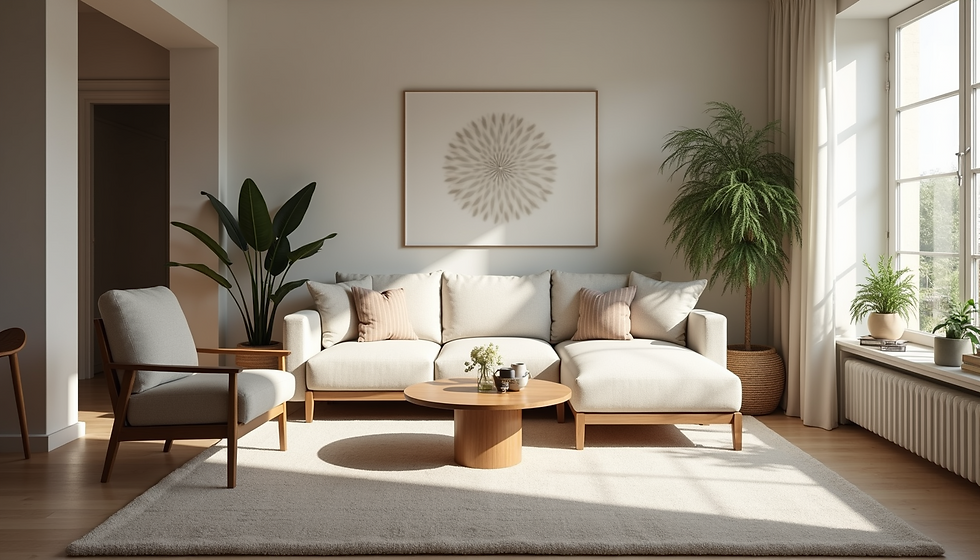Understanding the Basics of Interior Design
- Mia Ray
- May 29
- 4 min read
Updated: Jul 10
Interior design is an art and science that focuses on enhancing the interior of a space to achieve a healthier and more aesthetically pleasing environment. A well-designed interior can transform a dull room into a welcoming sanctuary. In this post, we will delve into the fundamentals of interior design, discuss its principles, and provide you with actionable tips for making your space a better one.
The Importance of Interior Design
Interior design is not just about arranging furniture or choosing colors; it's about creating a space that reflects the personality and lifestyle of its inhabitants. From residential homes to commercial spaces, interior design plays a crucial role in how we experience our environments.
One might wonder why interior design matters. According to a study by the American Society of Interior Designers, good design positively affects mood, productivity, and overall well-being. For example, an office with efficient layout and good lighting can boost employee morale significantly, leading to increased productivity.

Key Principles of Interior Design
Understanding the key principles of interior design is essential for anyone looking to create a balanced environment. Here are a few core concepts that you should keep in mind:
1. Space Planning
Space planning is about utilizing the available area effectively. It's crucial to assess how much space you have and how to best use it. For instance, in a small room, choosing furniture that serves multiple functions can help maximise space while ensuring comfort.
2. Color Theory
Colors can dictate the mood of a room. Warm colors like red and orange create energy, while cool colors like blue and green offer calmness. It’s a good idea to test paint samples on walls to see how colors look in various lighting conditions throughout the day.

3. Balance and Harmony
Balance in interior design refers to the distribution of visual weight in a space, which can be achieved through symmetrical or asymmetrical designs. Harmony, on the other hand, brings together different design elements to create a cohesive look.
4. Lighting
Lighting is a critical component of interior design. It can set the mood and highlight the best features of a room. Natural light should be maximised, while artificial light sources like lamps and overhead lights should be layered to provide flexibility.
5. Texture and Pattern
Adding texture and pattern can enhance visual interest. Mixing materials such as wood, metal, and textiles can create a more dynamic environment. For example, pairing a sleek glass table with a plush fabric sofa can offer an appealing contrast.

Choosing Furniture and Decor
When choosing furniture and decor, it's important to consider both aesthetics and functionality. Quality matters more than quantity when it comes to furnishing your space.
Selecting the Right Pieces
Opt for timeless pieces that can withstand changing trends. For instance, a well-crafted wooden table can be a beautiful focal point for years to come. When shopping for furniture, think about scale and proportion to ensure each piece fits well within the dimensions of the room.
Personal Touches
Incorporating personal elements like art, photographs, and heirlooms can make a space feel more like home. These pieces tell a story and add character to your interiors. Don’t be afraid to showcase your personality through your decor choices.
Tips for Successful Interior Design
Here are some practical tips to help you apply the principles of interior design effectively:
Plan on Paper: Before making changes, sketch out your ideas on paper. This can help you visualize your space and make informed decisions.
Consider Flow: Ensure there's a natural flow from one area to another. Avoid cluttering pathways and keep essential elements accessible.
Quality over Quantity: Invest in quality pieces that last. This doesn't mean you can’t mix in budget-friendly items, but having a few key quality assets makes a larger impact.
Stay Updated with Trends: While timeless design is crucial, being aware of current trends can offer new ways to refresh your space. This can be through color choices, decor themes, or popular furniture styles.
Seek Professional Help if Needed: If you feel overwhelmed, remember that there are professionals who can help. Consider looking into interior design services to guide you through the process.
Final Thoughts on Interior Design
Embracing the basics of interior design allows you to create spaces that are not only visually appealing but also functional and reflective of your unique tastes. Whether you are redesigning your living room, rethinking your office layout, or even sprucing up a small nook, applying the principles of interior design can lead to rewarding results.
By understanding space, color, balance, lighting, and texture, you can transform ordinary spaces into extraordinary experiences. Remember to add personal flair, invest in quality pieces, and plan thoroughly for your projects to yield the best results. Happy designing!



Comments